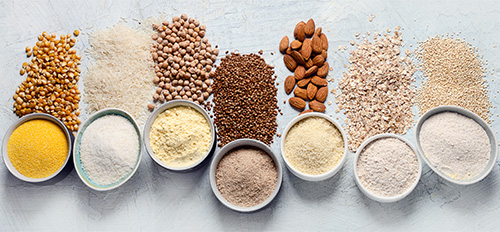Authored by Dr. Amber Hayden, DO
When it comes to gluten sensitivities, the new research shows they can have serious implications on our health.
While “overt” celiac may manifest with cramping, bloating, gas, and diarrhea, the reality is that most cases are “silent,” meaning there are no obvious symptoms, digestive or otherwise. Even larger numbers of people have the “latent” form, meaning their immune systems are predisposed to develop a response to gluten when triggered by certain conditions. Gluten sensitivity is so common now that we even have a CPT (Current Procedural Terminology) code for it.

In this article
- The gluten spectrum — from sensitivities to celiac disease and beyond
- The inside story — gluten sensitivity and what’s going on in the body
- Real help for gluten-sensitive women — the Women’s Health Network approach
- Looking beyond labels
We are now understanding that gluten has many more far-reaching effects than previously believed, and indicators of gluten sensitivity and celiac disease can show up in the form of low energy, fatigue, brain fog, skin rashes, numbness in the extremities, fibromyalgia, muscle and joint pain — even problems with coordination. And all forms, whether overt or silent, can have devastating long-term consequences all over the body.
As with leaky gut, dysbiosis, and other digestive disorders, poor nutrient absorption is just one concern. Over time, gluten-sensitive women who continue to eat gluten increase their risk for a host of inflammatory and autoimmune disorders, including osteoporosis, heart disease, rheumatoid arthritis, hypothyroidism, and more. We think that the secret to a long and happy life is a healthy digestive system, and these connections firmly underscore that belief.
What’s wonderful is that women suffering from any number of symptoms experience surprising relief from a gluten-free diet. And finding healthy, yummy foods that don’t contain gluten is not nearly as difficult today as it once was. It can take some time and attention, but we’ve seen so many women turn the corner on their health once they’ve investigated how gluten affects them.
So let’s take a closer look at how gluten — found in so many of our comfort foods — can affect our bodies if we are sensitive to it, and how we can learn how to live happily without it.
Understanding gluten sensitivity, celiac disease and more
There is a lot of confusion around gluten sensitivities vs. celiac disease, and for the most part, the conventional medical community continues to regard these as distinct entities. The standard advice is that patients with celiac disease have to follow a strict gluten-free diet (GFD) for life, while those who are mildly sensitive may get away with a slice of cake or bread every now and again. Functional medicine practitioners see no bright line between the two. If minor gluten sensitivity lies at one end of the spectrum, celiac disease falls at the far end, with incremental degrees in between. And even a mild sensitivity to gluten, depending on surrounding circumstances, can potentially develop into full-blown celiac disease.
Besides wide-ranging symptoms, celiac disease is generally associated with anatomical changes in the lining of the small intestine and the presence in the blood of certain antibodies, particularly antiendomysial, and anti–tissue transglutaminase antibodies. For years the gold standard for diagnosing it was intestinal biopsy, and it seems that the more damage the intestine has suffered, the more accurate antibody testing becomes. But not everyone with gluten sensitivity demonstrates these changes, and for the most part, modern medicine hasn’t done a very good job of testing for or diagnosing them. A recent study reported that about 47% of celiac patients are misdiagnosed, and of those with “classic” GI symptoms, 59% are told they have IBS. The exciting news is that more sensitive tests are being developed, and we’re now awaiting a saliva test you can do on your own to check for antibodies associated with gluten sensitivity. Knowing early on can help you prevent damage to your intestine from repeated gluten exposure, as well as negative effects elsewhere in the body.
Autoimmune disorders are ten times more likely in celiac patients than in the general population. Here are some common ones.
- Type 1 (autoimmune) diabetes
- Thyroid disease
- Addison’s disease
- Cardiomyopathy
- Sjögren’s syndrome
- Autoimmune liver disease
- Osteoporosis
- Rheumatoid arthritis
- Hair loss
What’s so astounding about gluten is that it can seriously undermine practically every system of the body. Historically, conventional medicine assumed the effects of celiac and gluten intolerance were limited to the gastrointestinal system. Any symptoms outside the gut in celiac patients were presumed to result from improper absorption of essential vitamins and minerals. Now we understand that inflammatory and autoimmune responses that arise from gluten sensitivity can impact your brain, muscles, skin, and bones, your liver and heart, and your endocrine system. Researchers are now connecting the dots between gluten intolerance and a wide array of autoimmune and inflammatory conditions (see box).
What else can gluten cause?
Even though gluten is a buzzword on the health front these days, many women aren’t able to find clear information about what actually happens inside the body of someone who is gluten-sensitive. First of all, there are many pieces to a gluten reaction in the body, involving genetics, enzyme action in the gut, inflammation, and immunity. Here’s just an overview of how they overlap.
- Genetics. Most people with gluten sensitivities carry a unique genetic code for their cell surface markers, the molecules on the cell membranes that allow immune cells to recognize each other. These markers are called HLA (human leukocyte antigens) class II molecules. Gluten sensitive people usually have one of two variations: HLA-DQ2 or HLA-DQ8. When these variations combine with a gluten particle and tissue transglutamase (TG2, an enzyme helpful in digesting gluten, which I explain below), your T-cells recognize the combination as “non-self” or foreign and stimulate the immune system to fight this particle as if it were a virus or bacteria not welcome in the body.
- Tissue transglutaminase (TG2). TG2 is an enzyme in the gut essential for gluten digestion. In a gluten-sensitive person, antibodies can be sent from the body to destroy this enzyme and prevent gluten digestion. But there are also other implications to TG2. It can break down gluten in two ways, depending on the environment of the gut and how much gluten is present. The lower the pH in the gut (making it more acidic) and the more gluten on board, the more TG2 will break down gluten to glutamic acid. Glutamic acid can then bind to HLA-DQ peptide complexes and stimulate T-cells to mount an immune response. But with a higher, more alkaline pH in the gut and little gluten on board, TG2 shifts to a more favorable breakdown.
- Inflammation and immunity. Inflammation is the process we undergo when our bodies are trying to fight a foreign substance or heal an injury. A flood of immune cells are sent to the damaged area — in this case the small intestine — to remove the “threat” and repair the tissue. But when the threat is actually part of what breaks gluten down (TG2), your immune system is attacking your own body and preventing the proper digestion of gluten. So not only has the body disabled the enzyme helpful in gluten digestion, it has also prompted the immune system to amplify inflammation. With an inflamed gut, several cytokines and other inflammatory mediators are released into the body, which can lead to system-wide inflammation. Especially if gluten is continually introduced to the gut, the cycle continues and the damage compounds. This is why it’s best to catch gluten sensitivities early on.
With local inflammation occurring in the mucosa of the gut, the structure of the gut wall can change, “flattening” a normally rugged terrain and leaving a less absorptive surface area. Not only does this compromise nutrient uptake, but as I outlined in the steps above, a sensitivity in the gut can instigate inflammation throughout the body and may eventually lead to inflammatory disorders.
Real help for gluten-sensitive women — the Women’s Health Network approach
If you’re like many women visiting practitioners, you may not be feeling like yourself, but aren’t able to pinpoint the cause. We would suggest an elimination diet where you remove the seven common allergens (including gluten, dairy, eggs, peanuts, soy, citrus, and corn). Our Digestive Health Program Diet can soothe your digestive system and help you figure out what foods you might be reacting to.
To anyone who thinks they may be sensitive to gluten, our bottom-line advice would be to eliminate it from your diet and see how you feel. Gluten sensitivity has such far reaching effects in the body — going without it is one relatively easy path to explore and it will be worth it to your health in the end. Removing gluten from your diet isn’t as difficult as it seems. You can have a perfectly natural, delicious, and nutritious diet without gluten.
Here are some ideas to help you better define your relationship to gluten — and how you can feel your best without it.
Take stock of your gluten tolerance. Unless you have celiac disease, you probably won’t have a reaction to gluten immediately after eating it. Pay attention to how you feel for a few weeks and look for less obvious symptoms like joint pain, fuzzy thinking, and low energy. You might even consider keeping a food journal for a month or so to try to map out patterns.
Talk with your family members. If celiac disease runs in your family, your chances of being gluten-sensitive are far higher than those without a family history. The majority of people go undiagnosed until their fourth, fifth, and sixth decades, so you may need to look up people in your family tree.
You can ask your practitioner for either a saliva test or the antibody blood test (keep in mind, the blood test has limited accuracy), but if you know you feel better off gluten even though test results are negative, continue avoiding it while investigating other possibilities.
Go gluten-free. Try removing gluten from your diet for a week or so, and see how you feel. Remember to be patient — for some people it takes a lot longer than they think to feel better. The good news is that there are so many wonderful gluten-free alternatives available now, and more are being introduced all the time. You can choose from a wide variety of naturally gluten-free foods at grocery stores, such as fresh fruits, unprocessed fish and meats, and gluten-free grain alternatives like quinoa.
You don’t have to give up baking because you can’t eat gluten. Substitutes for wheat flour can be used for many recipes. The key to this is watching the proportions. Here are some tips:
- If a recipe calls for one teaspoon of wheat flour, you can use 1-½ teaspoons of potato starch, cornstarch, rice flour, or arrowroot starch instead.
- One cup of wheat flour can be replaced with one cup of fine cornmeal, ¾-cup of coarse cornmeal, ¾-cup of rice flour, or 5/8-cup of potato flour.
You may also want to try some of the flourless recipes published on-line and in cookbooks for gluten-intolerant people. (See resources for gluten-free cooking.)
Many grains are low in or free of the more problematic wheat proteins mentioned above, but as discussed below, cross-contamination can be a major challenge, so you may want to avoid them at first, as you orient yourself to this way of life.
There are also gluten-free substitutes for many prepared foods and beverages, including breads, crackers, cookies, and beer. Some stores (particularly health-food stores) maintain lists of products that are either naturally or rendered gluten-free, but look for those that are prepared in dedicated, gluten-free facilities. If gluten-free prepared foods are not readily available at your local supermarket, they can be purchased on-line. Just be sure the product isn’t too high in sugar or starch.
Another problem when it comes to removing gluten from the diet is that it is hidden in so many things. Besides the obvious sources of gluten — breads, pasta, and baked goods — many foods contain gluten as an additive. Ingredients containing gluten are often added to “bulk up” foods like frozen meatballs and to thicken sauces under the name of “modified food starch.” Some medications, herbal supplements, and vitamins may contain gluten as a binding agent. You might also find gluten in your lipstick and even in the glue on your envelopes! If you have any doubts as to whether a medication or supplement contains hidden gluten, read the label carefully, talk to your pharmacist, or check the product information on the manufacturer’s website.
Always strive for diversity in your diet. Much of the grain eaten in this country is grown via monoculture, where acres upon acres of the same varieties of wheat, corn, and other grains are grown year after year. It’s likely that many of us are simply eating too much of it. Yes, whole wheat is particularly high in protein, as well as many essential micronutrients. But you’ll find that eating a diet rich in a variety of plant foods to be one of Mother Nature’s ways of keeping your systems balanced. There are so many other grains to choose from, and abundant, delicious root vegetables, too. You’ll find that you have better success avoiding gluten if you make a point of buying products that are fresh, organic, and unprocessed. The less processed your food, the easier it is to know what’s in it.
Shore up your nutritional foundation. It’s difficult for all of us to get the vitamins and minerals we need from our foods these days, no matter how carefully we eat. One way to cover your bases is to find a high-quality, gluten-free multivitamin — and remember to take it every day, too! This way you can be sure you’re getting the nutrition your body needs, especially with a unique diet.
Be aware of contamination. Food products can become contaminated with gluten if they come into contact with it. For instance, a knife that was used to cut bread should be washed thoroughly with soap and water before it is used to cut food for a person with celiac disease. Cross-contamination may also occur if bread and vegetables are cut on the same cutting board. Even foods we buy in the store that are labeled “gluten-free” can be contaminated, but some choices may be better than others. For example, steel-cut Irish oats processed in a oats-dedicated facility may have less gluten than mainstream name brands.
Enjoy meals out and with friends. If you are gluten sensitive, it doesn’t mean that you can never go out again! Explain your sensitivity to your host, and ask what’s on the menu for a dinner party — he or she may accommodate you, or perhaps you can offer to help cook or bring a dish to share!
Restaurants may also accommodate special requests if you let them know in advance about your sensitivity (after all, they don’t want you to get sick from their food). Many chefs are aware of the need for gluten-free menu items, and growing numbers of restaurants take part in the Gluten-Free Restaurant Awareness Program and the Gluten-Free Registry. You can go on-line and find a participating restaurant simply by searching “gluten-free restaurant” on the internet. Many popular chain restaurants have entire gluten-free menus for people with gluten sensitivities — including those with celiac disease. You can even get gluten-free beer!
Looking beyond labels
We now know that sensitivity to gluten can have huge implications in the body and mind. Research is now proving it — and thankfully we have better testing and improved solutions for women with celiac disease and gluten intolerance than ever before. Living without gluten doesn’t have to seem like a chore. You can have gluten-free pizza night and find new and delicious gluten-free foods to create in your kitchen!
For many people with gluten sensitivities, awareness, understanding, and good choices have brought them tremendous wellness, vitality, and a special energy that is often shared with friends and family. Listen to what your body needs and you will never regret it!
1 Feighery, C. 1999. Fortnightly review: Coeliac disease. BMJ, 319 (24), 236–239. URL: https://www.bmj.com/cgi/content/full/319/7204/236 (accessed 11.14.2008).
2 Green, P., & Cellier, C. 2007. Celiac disease. NEJM, 357 (17), 1731–1743. URL: https://content.nejm.org/cgi/content/full/357/17/1731 (accessed 11.15.2008).
3 Rostom, A., et al. 2005. The diagnostic accuracy of serologic tests for celiac disease: A systematic review. Gastroenterol., 128 (4 Suppl. 1), S38–S46. URL (abstract): https://www.ncbi.nlm.nih.gov/pubmed/15825125 (accessed 11.15.2008).
4 Lubel, J., et al. 2005. An unexpected cause of macroscopic haematuria. Med. J. Austr., 183 (6), 321–323. URL: https://www.mja.com.au/public/issues/183_06_190905/lub10368_fm.html (accessed 11.15.2008).
5 Duggan, J. 2004. Coeliac disease: The great imitator. Med. J. Aust., 180, 524–526. URL: https://www.mja.com.au/public/issues/180_10_170504/dug10818_fm.html (accessed 11.15.2008).
6 O’Bryan, T. “Unlocking the secrets of gluten sensitivity: Implications for neurological, musculoskeletal, and immune health.” Gluten Sensitivity Seminar, March–December 2008.
7 Green, P., et al. 2005. Mechanisms underlying celiac disease and its neurologic manifestations. Cell Mol. Life Sci., 62, 791–799. URL: (abstract): https://www.ncbi.nlm.nih.gov/pubmed/15868404 (accessed 11.14.2008).
Peters, U., et al. 2003. Causes of death with celiac disease in population-based Swedish cohort. Arch. Intern. Med., 163 (13), 1566–1572. URL: https://archinte.ama-assn.org/cgi/content/full/163/13/1566 (accessed 11.15.2008).
8 Helms, S. 2005.
9 Green, P., et al. 2001. Characteristics of adult celiac disease in the USA: Results of a national survey. Am. J. Gastroenterol., 96 (1), 126–131. URL (abstract): https://www.ncbi.nlm.nih.gov/pubmed/11197241 (accessed 11.15.2008).
10 Akobeng, A., & Thomas, A. 2008. Systematic review: Tolerable amount of gluten for people with coeliac disease. Aliment. Pharmacol. Ther., 27, 1044–1052.
As discussed in:
Vega, C. 2008. How much gluten is too much? A best-evidence review of celiac disease. URL: https://www.medscape.com/viewarticle/580381 (accessed 11.15.2008).
11 Thompson, T. 2004. Gluten contamination of commercial oat products in the United States. NEJM, 351 (19), 2021–2022. URL: https://content.nejm.org/cgi/content/full/351/19/2021-a (accessed 11.15.2008).
Further reading
Schapira, M., et al. 2003. Epidemiology of coeliac disease. Acta Gastroenterol. Belg., 66 (3), 234-236. URL (abstract): https://www.ncbi.nlm.nih.gov/pubmed/14618955 (accessed 11.15.2008).
Green, P., et al. 2001. Characteristics of adult celiac disease in the USA: Results of a national survey. Am. J. Gastroenterol., 96 (1), 126–131. URL (abstract): https://www.ncbi.nlm.nih.gov/pubmed/11197241 (accessed 11.15.2008).
Reference on autoimmune disorders associated with gluten enteropathy
Helms, S. 2005. Celiac disease and gluten-associated diseases. Alt. Med. Rev., 10 (3), 172–192. URL (PDF): https://www.thorne.com/media/Celiac.pdf (accessed 11.15.2008).










